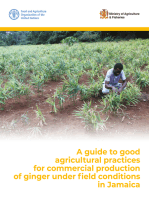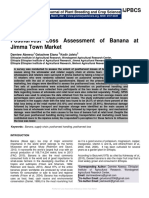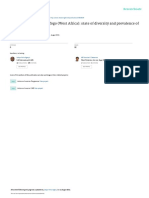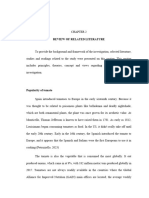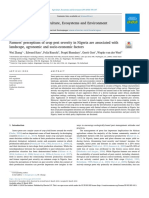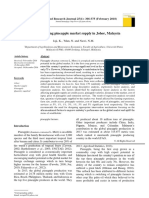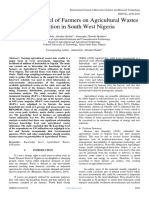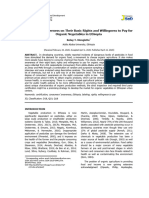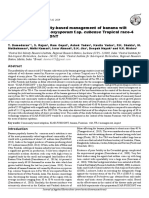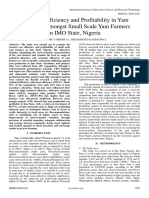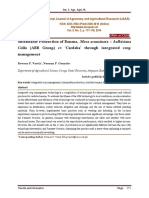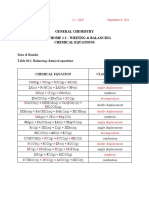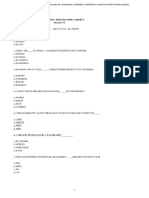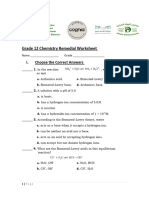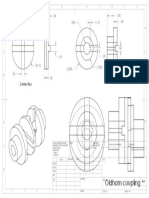Professional Documents
Culture Documents
Assessment On Post-Harvest Losses of Mango (Mangifera Indica L) and Allied Fungal Pathogens in Gambella Town Market, Southwest Ethiopia
Assessment On Post-Harvest Losses of Mango (Mangifera Indica L) and Allied Fungal Pathogens in Gambella Town Market, Southwest Ethiopia
Original Title
Copyright
Available Formats
Share this document
Did you find this document useful?
Is this content inappropriate?
Report this DocumentCopyright:
Available Formats
Assessment On Post-Harvest Losses of Mango (Mangifera Indica L) and Allied Fungal Pathogens in Gambella Town Market, Southwest Ethiopia
Assessment On Post-Harvest Losses of Mango (Mangifera Indica L) and Allied Fungal Pathogens in Gambella Town Market, Southwest Ethiopia
Copyright:
Available Formats
Volume 8, Issue 11, November 2023 International Journal of Innovative Science and Research Technology
ISSN No:-2456-2165
Assessment on Post-Harvest Losses of Mango
(Mangifera indica L) and Allied Fungal Pathogens
in Gambella Town Market, Southwest Ethiopia
Solomon Nigusu*and MihretuYonas*
*Gmbella UniversityCollege of Agriculture and Natural
Resource Department of Plant Science and Horticulture, Gambella, Ethiopia, P.O.Box 126
Abstract:- The matter of post-harvest losses is extremely 400 AD (Yadav and Singh, 2017). It is the second among
important in the efforts to fightfamine, increaserevenue fruit crops in Ethiopia in its production coverage and
generations and recover food security in the world's economicstanding next to banana in Ethiopia. The largest
poorest countries. The greatestsignificantissues causing mango producing areas in Ethiopia are Harari region, west
countless economical loss of mango fruits are postharvest and east Oromia, Southern Nations, Nationalities, and
fungal diseases caused by absence of proper People’s Region (SNNPR), BenishangulGumuz Region,
management along postharvest chains. This study was Gambella Region and Amhara region which are valued to be
carried out to assess mango fruits postharvest loss, producing 35% of the majority of fruits produced about the
managementdoes and recognize the main allied agents of country (Akrong 2020; Fleming, 2020; Hagoset al., 2020).
postharvest fungal pathogens in Gambella town market. Western Ethiopia, especially the two zones (East and West)
Assessment was carried out by means of purposive of Wollega, of Oromia regional state, which is located in the
sampling to select the study part, followed by simple upper Blue Nile valley, is suitable for the production of
chance sampling to gather data through observation and mangoes (Temesgen, 2014). Mangoes are full-grown by the
interview. Fungi isolation was done at laboratory by mainstream of farmers living in aboutGambella town near
culturing on potato dextrose agar media under Baro bank River and farmers in the region were depend on
controlled growth conditions. The studyoutcomeshowed on old and largeincontrollable mango plants found in nature.
that losses of mango fruits due to spoilage and physical
damage were common problems for all fruit sellers. Mango fruits are extremely healthful, simplyedible and
Post-harvest loss of mango fruit was occurred in wide consumption is due to its sensory features, and mainly
different quantity along value chain actors. The most its good-looking texture and essencetype mango fruit
post-harvest loss of mango fruits occurred at market popular by the clients. Mango fruit has a high nutritive value
stage 23.33% and followed by harvesting stage 20%. and health welfares due to significant components such as
Market handling does such as lack of hygiene, phytochemicals. It is rich source of vitamins C, minerals, in
temperature management;inadequate packaging and dietary fiber, provitamin A, carotenoids and varied
transportation problems were recognised among the polyphenols (Esguerraet al., 2018). According to
mutual causes for mango fruit losses. The maximum Maldonado-Celiset al (2019) studies,mango fruit
mango fruit injury 40% was noted in sample taken from components can be assembled into macronutrients
retailers’ and the allied disease incidence 32% and (carbohydrates, proteins, amino acids, lipids, fatty, and
severity were 16% in the study part. Morphological organic acids), micronutrients (vitamins and minerals), and
documentation of pure culture indicated that most fungi phytochemicals (phenolic, polyphenol, pigments, and
associated with mango fruits loss was Colletotrichumspp volatile constituents). The nutritional, non-nutritional, and
40.51% among six genera of fungi isolated from mango water contents of mango fruit differreliant of the cultivar
fruits in Gambella town market. In general post- and numerous pre harvest and post-harvestissues (Corrales-
harvestlosses of mango fruits in the study part were Bernal et al., 2014).
accelerated by different factors. Furthermore, the
pathogenic of isolated fungi need to study to state their Even though mango fruits are extremelyessential as
effect on post-harvest loss of mango fruits including to nutritious and economically significant fruits, they knew by
controlling methods. different production limitations. According to some studies,
erratic rainfall, pest problems, improper agronomy practices,
Keywords:- Incidence and severity, post-harvest fungal lack of improved varieties, post-harvest losses and problem
pathogen, mango fruit handling, Value chain actors. of infrastructure were bottleneck of mango production in
Ethiopia (Honja, 2014; Siddiqet al., 2017). Mango is
I. INTRODUCTION anextremely perishable fruit, has a short shelf life and
vulnerable to environmental stress especially high
The mango (MangiferaindicaL.) is origin to India temperature. The perishable nature of harvest, lower
(Yadav and Singh, 2017) and most important fruit technology, and absence of awareness among makers as
commerciallycultured in tropical and subtropical areas of the well as market performerscaused in poor management of the
world (Mitra, 1997; Esguerraet al., 2018). Gradually, the mango fruits (Aberaet al., 2020). Substantialamounts of
mango moved from its centre of origin from Asia to the mangoes are lost each year during collecting, transport and
Middle East, East Africa and South America startabout 300- marketing (Hassan, 2010; Alamet al., 2019). Due to its
IJISRT23NOV2283 www.ijisrt.com 2639
Volume 8, Issue 11, November 2023 International Journal of Innovative Science and Research Technology
ISSN No:-2456-2165
perishable nature mango fruits necessitysupreme care plant pathology laboratory. Jimma University is located in
throughcollecting, cooling, storing, transporting, grading the city of Jimma Zone, located around 352 kilometres
and storing (Kayieret al., 2019).Fungal pathogens are southwest of Addis Ababa in Oromia region, Ethiopia.
frequently encountered on rotting mango fruits and were the Mango fruits post-harvest loss valuation and experiments
main agents of fruit rot after harvest and responsible for were done from March, 2021 to January, 2022.
postharvest diseases studied early by Sangchote (1989),
Rawal (1998) and Johnson (2008). The matter of post- B. Sampling and Data Collections Methods
harvest losses is extremelysignificant in the efforts to fight Pertinent data were collected using altered
hunger, increaseincome and progress food security in the questionnaires accepted from La Gra (1990) with semi
world's humblest countries like Ethiopia. A lot of structured interviews, formal questionnaires, direct
researcherstraced the decrease of post-harvest losses is observations and retrospective method (organizational
stated as akeysubjectconstituent of ensuring diagrams). The post-harvestmanagementlinkedstudies were
upcomingworldwide food sanctuary (Aulakhet al., 2013; ready; pre tested with sample defendants, rechecked for its
Garikai, 2014; Belik, 2018). precision for clear sympathetic and replying, and spread to
the respective selected representative respondents in
Moreover, bestinvestigationdirected on postharvest Gambella town market. The data were collected both from
losses of mango attentive on determinants Market Supply survey (Primary and secondary data) and laboratory
(Wake et al., 2013; Husen and Yimer, 20014; Kabeta and experiments. Yamane (1967) sampling formula with a 90
Alemu, 2019; Hagoset al., 2020). Recently, Tarekegn and percent confidence level and population proportional to size
Kelem (2022) studied about postharvest loss of mango along (PPS) to each residence of market was applied to get
value chain in Gamo zone SNNPR. However, not at allwide representative households respondents. Where “n” is sample
study has been done to findpost-harvest loss of mango from size for this study were (98), “N” is total number of mango
farm entrance to the point of eating due to fruits sellers were (4228) and “e” is margin of error at 10
unsuitablecollecting, post-harvestmanagement, carriage, percent.
intermediaries’ misconducts, storage and other details in
Gambella region, Ethiopia. There is no more information n= N .
about mango fruits handling practice in Gambella town 1+N (e) 2
market and causing agents of mango fruits loss. Therefore, it
suitspredictable to find the procedures and networks where Lastly, focus group discussions (FGDs) were led with
important losses and at what degree occur. A better importantgoal groups to get observations of different
understanding mango fruits handling practices could lead to stakeholders along with the product chain system and to
developing technology and does to decreasepost-harvest cross check the reliability of the information was gained.
losses of mango. However, little is understood about the Accordingly, the group discussions of producers were
effectallied fungal deterioration of the mango fruits. separated into two subgroups (men and women) for the
Additional, not at allwide study has been carried out so FGD. Extra and essentialdata was also gotten from key
distant to trace fungi allied with mango fruit spoilage informants, like development agents, agricultural officers,
causing losses and fungal deterioration. Hence, there is a and research professionals by connecting two FGDs with 7
vigorousessential to appreciate the impact of fungi spoilage members. The mango fruits postharvest management
during mango fruit marketing on the postharvest losses due doeswere also detected and noted. Mango fruits were bought
to fungal pathogens. Therefore, this study expected to from Gambella market traders (whole seller, retailer, farmer
evaluatedifferent postharvest doesaffecting postharvest and open market) and used for laboratory experiments to
losses and identified fungal pathogens accountable for the find the fungi allied mango fruit losing in the study area.
main postharvest deterioration of mango fruits in Gambella C. Data collected
town market.
Mango fruits harvesting tools
II. MATERIALS THEN METHODS To collect data regarding tools of mango fruits
A. Explanation of the Study Areas harvesting, the farmers were assessed and interviewed.
The postharvest loss valuation was carried out in During this data collected, about labour, harvesting tools,
Gambella town market, Gambella regional state of Ethiopia. harvesting method and time of harvesting was discussed and
Gambella region is one of eleven regional states of Ethiopia interviewed in the study area. All activities of postharvest
found at the south western region of the country and organization such as pre-cooling, grading, packaging,
bounded by South Sudan to the west, KellemWollega Zone, storage, loading and carriage were interviewed and stated.
Ilu Ababor Zone and Sheka Zone.Gambella is a name for Mango fruit post-harvest loss along value chain
both the regional state and the capital city of the region, Information were collected on mango fruits losses
which is located about 753 kilometres southwest of the happened in the harvesting, pre-cooling, field storage,
capital city of the country Addis Ababa perched at an sorting and grading, packaging, loading/unloading,
elevation of 526 meters above sea level. Gambella town transportation and marketing stages. Amount of producing
market is located in Gambella regional state capital city /buying/ and losing of mango fruits were interviewed in the
where fruits, vegetables, cereals and other products were study area.
sold. The laboratory investigation was directed at Jimma
University College of Agriculture and Veterinary Medicine,
IJISRT23NOV2283 www.ijisrt.com 2640
Volume 8, Issue 11, November 2023 International Journal of Innovative Science and Research Technology
ISSN No:-2456-2165
Mango fruits handling practices in the Gambella town apparently healthy looking were sampled purposively
market centred on the capacity sell from the farmers selling fruits in
Information concentrating on issues linked to loss and farmers (n= 25), open market (n = 25), wholesalers (n =25),
their causes, farmer's exercise of management the mango and retailers (n = 25) with three replications. All the mango
fruits from production pending they take it to their buyer; fruits were transported to the laboratory and kept at room
their contact with the respective actors and government and temperature for additionalstudy of fruit injury and quiescent
physical flows of produce were collected. Moreover, (latent) contagion of the pathogens. The contagion of fungal
through data collection, temperature of the marketing part pathogens were documented using different approaches such
was noted three times in a day (morning, afternoon, and as looking at the appearance of rotten fruit, including the
evening) for successive 5 days, and the temperature of one color sign of the pathogen spore, and site of
day was averaged. contagionplaces. Following the documentation of infections,
disease incidence was calculated as number of infected
Fruit damage, disease incidence and severity valuation fruits display any single symptom out of entire number of
To measure percentage of mango fruits injury and test mango fruits sampled.
for fungal pathogen infection, representative samples (a total
of 100 mango fruits) composed of both damaged and
Percent of disease incidence= Number of infected fruits x100
Total number of fruit samples
Percentages of mango fruit damage were assessed and calculated using the following equation.
Percentage of mango fruits damage= Number of damaged mango fruits x 100
Total number of mango fruit samples
The disease harshness study was undertaken by >5%–25%, >25%–50%, >50%–75%, and >75% scored 2, 3,
detecting the fungal symptom record of disease levels 4, 5, and 6, respectively (Duamkhanmanee, 2008). The
according to the diseased surface part on the fruits. It was percent severity index of fungal impurity was then measured
measured on a 1–6 scale in which no diseased surface part from the numerical grades of the entire samples using the
scored 1, whereas the diseased surface parts of >0%–5%, next formula.
Percent severity index = Sum of numerical ratings x 100
Total number of mango fruit examined x maximum grade
Media preparation and growth conditions for fungi Isolation and documentation of fungal pathogens allied
culture with mango fruit
The media was prepared from PDA for fungi growth The samples collected from unalike mango sellers were
according to media fungi media preparation methods. Potato first eroded in blow water and then the fruits that
dextrose agar is the common media for any fungi growth in showedindications of fungal contagion were designated for
the laboratory under controlled growth conditions. PDA 39 fungal separation. The tissues were cut from lively lesions
gram was mixed in 1L of sterilized water. The mixed PDA and symptom showed surface of the mango fruits was used.
was stirred by magnet stirrer to mix well under hot The exterior of mango fruits tissues were sterilized by
condition. The well stirred and mixed media of PDA was soaking in freshly readyNaOCl (25 v/v) for 5 min. After
sterilized at 120 OC temperature and 105Kpa pressure for 15 three sequential washings in sterile purified water, mango
minute in autoclave. The sterilized media was poured in fruit tissues were engaged (four pieces per plate) on Potato
Petri dish under laminar air flow cabinet and left for 30 Dextrose Agar (PDA) and nursed at 25°C in the incubator
minute to media solidify and cool. The solidified and cooled for 3-7 days. The colonies emerged from each plated fruit
media were used for the experiments. The inoculated media tissues were cleaned and sub-cultured on the PDA media
were placed in growth chamber at 25 OC temperatures with after 6 days. The plates were nursed at 25°C under
good moisture. These media were replaced randomly in the comparablesituations, and the arrangements were
growth chamber with completely randomized design. The detectedpending the organisms convertedcompletely grown.
experiment done two times to get proper results and Single spore cultures of the fungus was then organized on
reducing error in the study. All growth conditions PDA slants in test tubes, and the empathy and description of
recommend for fungi growth were controlled and well noted the fungal separates were carried out centred on cultural and
in the laboratory. Similar and the some condition were morphological structures labelled in Marasaset al., (2001).
maintained for each experiment and all activities were The structure and morphological description was done by
equally applied for the study. preparing fungi fully grew on slide for identify under
microscope. The prepared slide where place under
microscope and morphology of fungi were considered with
three times pre Petri dish.
IJISRT23NOV2283 www.ijisrt.com 2641
Volume 8, Issue 11, November 2023 International Journal of Innovative Science and Research Technology
ISSN No:-2456-2165
A B
C D
E F
Fig. 1: Photo captured during data collection (A) Transporting mango fruits by cart, (B) Mango fruits transporting by human
shoulder, (C) Packaging materials at market, (D) mango fruits in the Gambella town market captured by /CdeAyom, 2020/, (C)
temperature management and (F) Mango fruits not sort and graded.
D. Data Analysis III. RESULTS AND DISCUSSIONS
The freshinformation from the survey questionnaire
wasnoted, ordered and investigated using SPSS (version A. Socio-Demographic Characteristics of the Study Area
16.0) and Microsoft Excel 2007. Appropriate mathematical Among 98 mango fruits sellers interviewed, their gender,
calculations and inferences were made consequently. age, marital status, and educational ranks were specified
Expressive statistical examination (means, standard (Table 1). As result traced in Table 1, in gender group, 35
deviation, percentage and Chi-square) were used in (64.29 %) of respondents were females and rest of them
describing socio demographic, post- were males and showed that the females were tangled much
harvestmanagementperforms and alliedpost-harvest loss of in mango fruits sale. Among the age clusters, the maximum
mango fruits. Correlation analysis was used to search the of 30.61% members were between 35-45 years of age. The
relationship between post-harvest handling does and post- level of education differs among the gender and age groups,
harvest losses of mango fruits. An independent sample t-test 36.74% of them were illiterates, 63.26% of them were in
was also conducted to observe the significant effect of post- different levels (elementary to high school) education. More
harvest handling practices along with the mango fruits than 63.26% of literate respondents have attentiveness on
supply chain on its loss. Matrix grade was used to label the the effect of inadequatemanagementdoes on the quality of
relationship between socio demographic and mango fruits mango fruits. Alikethought was made by Olayemi,
post-harvest loss and to vital mango fruit marketing Adegbola, Bamishaiye, and Awagu (2012) who stated that
difficulties. peoples on secondary educational stages can simplyknow
the postharvest managementdoes more than peoples on
primary educational ranks. Babalola (2011) also stated that
education allowsunderstanding the result of
managementdoes on the postharvest loss of the produces
and mains to better managementensure than illiterate.
IJISRT23NOV2283 www.ijisrt.com 2642
Volume 8, Issue 11, November 2023 International Journal of Innovative Science and Research Technology
ISSN No:-2456-2165
Table 1: Socio-demographic features of mango fruit sellers in Gambella town market
Variables in the study Frequency Percentage
Sex Male 35 35.71
Female 63 64.29
Age < 25 15 15.31
25 – 35 22 22.45
35 – 45 30 30.61
45 – 55 21 21.43
>55 10 10.20
Marital status Single 33 33.67
Married 60 61.23
Divorced 5 5.10
Education level Literate 36 36.74
Illiterate 62 63.26
Source: Own data computations (2022)
B. Post-Harvest Loss along the Mango Fruit Value Chain harvesting technology, awareness of societies about
and their Practices in the study area harvesting strategies, lack of harvesting materials,
Rendering to survey outcome mango fruits losses were mishandling during harvest and mismanagement were the
happened at collecting, pre-cooling, storing, sorting and driving force to mango fruits post-harvest loss in Gambella.
grading, packaging, loading/unloading, transportation, and At harvesting, separating the mango fruit from the stem
marketing and consumers stage with different percent of grounds the issue of resin and the sap, which has a low pH,
loss due to mismanagement and handling practices. can injury the fruit superficial. This injuryincreases the
Activities of the value chain actors and their contribution in addition of red and black spots and deteriorationgrowth on
mango fruits post-harvest losses were stated in the the peel, and concessions the fruit’s excellence. The
following. harvesters were not drained the sap from the fruit or
preserved to reduce the occurrence of sap burn. This was
Mango fruit harvesting practices and loss also one causative agent that enhancing post-harvest losing
Rendering to anemphasis group conversation with of mango fruits. The losing at harvesting stage 20% in this
mango producers, mango is collectedtypically once a year in study held second rank from value chain actors next to
the study part. This season for harvesting mango fruit starts market loss according to survey result (Figure 3). Therefore,
from February to May. In the study part, mango fruits were lack of harvesting technology, awareness of societies about
harvested regularly by family labor (78.5%), while the rest harvesting strategies, lack of harvesting materials,
were harvested by daily laborers (21.5%). Through the mishandling during harvest and mismanagement were the
harvesting time they were harvesting both matured and driving force to mango fruits post-harvest loss in Gambella.
immature mango by mixing. With respects to harvesting
implements, the defendantssettle that the better harvesting Pre-cooling and field storage of mango fruits and loss
apparatuses and mechanisms were not In this study area the farmers were not pre-cooling of
extensivelyexperienced by mango producers in Gambella. mango fruits to keep the excellence of fruits due to lack of
They were harvesting mango fruits in traditional ways and awareness of pre-cooling values. According to respondents
hand picking by ascending the mango tree. Old-styleways of in the study area the developed green fruits were not
collectinginstruments like trembling of the mango tree reserved at room temperature for around 4-10 days liable
branches, picking with a twig and cutting the fruit outlet upon the maturity for storage. The shelf life of mango fruits
were used in the study part. The farmers were harvesting the were not lengthy by pre-cooling, chemical treatments, low
mango fruits with stalk of the fruits in the study part. There temperature and in another mechanizes according to
were no technology provided in the study area to support respondent reflect. This study in line with Alkan and Kumar,
farmers to harvest in suitable manner and they were not (2018) studies stated thatover ripe mango fruits were more
trained how to harvesting the mango fruits in safety ways. vulnerable to post-harvest illness and mechanical injury,
while young fruit are prone to chilling pressurethrough cold
Post-harvest loss and excellencedecline during storage.
collecting and managementmethods were recognised by
20% of the respondents (Figure 3). As the respondents According to result in this study producers were
stated, they did not use the suggestedapparatus and directly took the mango fruits to the markets without any
resources for collecting and management due to absence of pre-cooling and field storage, due to this activities mango
admittance to bettercollecting technologies in the study part. fruits lost in the study around 6.66% and 3.33% respectively
These serious the risks of postharvest loss and quality (Figure 3). This losing was lower than another mango fruits
deterioration of mango fruits in the study area. This study value chain actors according result revealed in (Figure 3)
was not agree with the finding of Tarekegn and Kelem, when compared with each other. Pre-cooling really not
(2022) mango fruit lost was 73% at Gamo zone in SNNPR recommended for mango fruits being put through typical
in Ethiopia. This was due difference of harvesting methods postharvest handling and it was not showed more effect on
and techniques in the study area. Therefore, lack of post-harvest loss of mango fruits in the study part. However,
IJISRT23NOV2283 www.ijisrt.com 2643
Volume 8, Issue 11, November 2023 International Journal of Innovative Science and Research Technology
ISSN No:-2456-2165
pre-cooling was an effective and important strategy used for Mango fruits packaging practices
maintaining the quality of produce postharvest, to Wooden boxes, Plastic, sack, safa and basket were
implement pre-cooling into producing systems to prolong commonly used for packaging materials according to
the life and reservation the health of fresh mango fruits if respondent (Figure 1 C). Some of farmers were not used
adopted. packaging materials instead they were cutting the mango
fruits with stalk and hanging on the stem to take the markets
Sorting and grading mango fruit loss (Figure 1 B). About 31.25% of the defendants were used
Mango fruits producers in study area about 65% were Safa for wrapping mango fruits (Figure 2 C) and charted
sorting and grading the mango fruits based on the maturity, wooden box 25%, whereas the lingering of them were used
size, shape, freedom from disease, weight and color for basket, plastic, and sack (Figure 2). We detected that the
selling and transporting. According to the producers timber boxes they have been used were too large and too
responding most of producers were sorting the mango fruits uneven to deliverdefence and abundant of the fruits on the
before selling and estimated prices of each sorted mango lowest of the timber boxes were crumpled and
fruits and some of them were not sort and grading (Figure 1 classicallywaste before sale. However, the Safa was the best
C and F). For fresh marketing, the recognized methods of packaging materials in the study area and no more mango
classifying of mango fruits were physicalclassifying in the fruits damaged at the bottom due to over load. In this study
study part. There was no technology and machine developed area safawas most prominent packaging materials and best
for mango fruits grading and sorting in Gambella town tools people used in mango fruits holding and it held first
market. Farmers and producers were majorly sorting mango rank among all packaging materials stated (Figure 2) with
based on maturity and prices according respondent confirm 31.25 % according observation and respondent reflect
in the study area.Mango fruits loss was occurred about 10% (Figure 1 C).
according result traced in (Figure 3) and it was lower post-
harvest loss of mango fruits when compared with another Mango fruits post-harvest loss at packaging stage
value chain actors. Over ripening, mechanical injuring lower than another value chain actors according to
during harvest, immature, deformed shape, damaged due to respondents confirm about 3.33% were lost (Figure 3).
bird feeding and insect, cracking and price levels were some Related observation was made by Tarekegn and Kelem,
causing agents of mango fruit losing at this stage of value (2022) who stated a high mechanical damage to mango
chain actor according to respondent confirms. Mango fruits fruits crowded in timberbanger which could be due to
lost at this stage were lower than mango lost at marketing density and exteriorstaininginjuries. Mango fruits produced
levels according result stated (Figure 3). around Gambella town were directly transported to market
and packaging material encourage them to reducing loss
according respondent confirm. Focus group discussion and
key informative also encourage the idea of defendants in the
study part and stated that mango fruit packaging materials
help producers to reduce loss when compared with other
value chain actors (Figure 4).
Fig. 2: Percentage of respondent handling mango fruits using different packaging materials
Mango fruits transportation to the market and loss from the orchards, but they were not accepted in the study
The producers were transporting the mango fruits to the area in Gambella. Technology such as refrigerated vans/
markets using human labors, cart, Bajaj and other vehicles vesselsvaluable for extended distance carriage and help in
in the study area. Under active carriage situations shaking decreasing the postharvest losses was not adopted in this
affects in staining, deterioration and low price of mango study area. For carriagedrives, around 60% of defendants
fruits. The truck has been accepted as the used an old-style trolley, shoulder hanging and cart (Figure
greatestsuitablestyle of carriage due to its informaltactic 1 A and B), while nativegatherers and vendors use cars to
IJISRT23NOV2283 www.ijisrt.com 2644
Volume 8, Issue 11, November 2023 International Journal of Innovative Science and Research Technology
ISSN No:-2456-2165
carriage mango fruits. This study was not related with the means most sold mango fruits more than buyers according
finding of Tarekegn and Kelem, (2022) mango fruits to traders’ response in the study area.
transportation 87% at Gamo Zone in SNNPR by trolley and Unintendedperformersconnecting in mango value chain
cart. This may due to difference place of production area, were groups such as office of agriculture, trade office;
condition, strategies of transporting, management and research institutions, NGOs and financial institutions were
infrastructure in the study area. not more encourage them in required level. At market, there
was no vendible mango with small mechanical injury and
Due to transportation about 16.67% of mango fruits mango with slight decay in Gambella town market, this
were lost in this study area (Figure 3) and it was ranked enhancing mango fruits loss. This finding was related with
third among value chain actors in quantity of mango fruit the study of Alamet al., (2019), marketable mango losing
loss. The producers were transported mango fruits to the due to mechanical and decay injuries in Bangladesh. Market
markets in old-style ways this enhancing post-harvest loss of accessibility was a major bottleneck in post-harvest loss of
fruits. A study by Benyamet al, (2018) in Ethiopia stated mango fruits in Gambella town market.
that the use of old-style ways of carriage was increased post-
harvest loss. Means of their transportation such shoulder Mango fruits loading/unloading and loss
holding fruits, hand cart, safa and other materials were open Mango fruit loading/unloading in Gambella town market
and directly sunlight gain the fruits that increasing was scored and noted according to respondents reflects. In
metabolism activities of fruits. There were no technology this value chain actors the producers loading mango fruits
accepted for fruits management in the study area and there by throw means they were not replace the fruits on cart,
were trained men power encases of post-harvest Bajaj, truck and others means of transporting. This caused
management of fruits. According to respondent in study area mango fruits crack and breakage that enhancing fruit decay
mango fruits lost due to transportation services were high and loss. Due to this value chain actor about 6.67% mango
and focus group and key informative also confirm this fruits were lost in the study area. This losing was lower
result. Generally, lack of refrigerated transport, Lack of when compared with another value chain actors (Figure 3).
suitable transport system, poor infrastructure, loading and According focus group confirmed the producers have no
unloading doeswere enhancedpost-harvest loss of mango experience and knowledge of mango fruits
fruits in Gambella town market according the respondent loading/unloading; theoretically these were encouraging
direction. post-harvest loss of fruits. Therefore, uncaring handling of
free/packed mango fruits through loading and unloading
Mango fruits market accesses and loss producing loss.
The nativedealersbought mango fruits from producers on
anamount basis in the study part. More sources of mango Mango fruits loss at consumers
fruits happen from February to May in Gambella town According to result obtained from the respondents the
market. On the twitch and finish of the collectingperiod, the mango fruits lost at consumers levels were 10% among
fees of mango fruit were peak. At meddle of harvesting value chain actors (Figure 3).Physical damage was
mango fruits at high peak the prices fall and mango fruits pronounced in the harvesting system due to the lack of
accessibility found in the Gambella town market no more knowledge and training that causing mango fruits loss.
buyers found (Figure 1 D). A peak harvesting and Physiological losses, pathological losses, injure loss and
accessibility of mango fruits in the market it becomes cheap breakings of fruits were some reason accelerated the mango
and loss also occurred at the hands of traders. fruits loss at consumers’ stage. According to Adewoyinet
al, (2022) studies on fruits their results indicate fruits loss at
According to respondents confirm there were driving stage of consumers’ among value chain actors rage 5-10%.
force such as brokers, juice maker cafe and lack of industry This study also agrees with the finding of these scientists
of using mango fruits causing mango loss in the market. and the reason behind post-harvest loss were accelerated the
Under this value chain actor mongo fruits were lost 23.33% mango fruits damage in the study part. According to the
and held first rank among all value chain actors as results outcome stated in the Figure 3 the post-harvest losing of
indicated in (Figure 3). There were no infrastructure and mango fruits in the study part were lower than mango fruits
high peak producing mango fruits due to seasonality were lost at harvesting, marketing and transportation in Gambella
also another factor that affect the mango fruits loss. town markets.
Performerstangled in mango input source, making, selling
and worthcount for gettingrevenue as well as incomegetting
IJISRT23NOV2283 www.ijisrt.com 2645
Volume 8, Issue 11, November 2023 International Journal of Innovative Science and Research Technology
ISSN No:-2456-2165
Fig. 3: Post harvest losses of mango fruits along value chain actors in Gambella town
Generally, the results of this study shown that the ambient situations. According the result shown in (Figure 4)
postharvest damage of mango fruits at diversephases of the traders were used different method to manage
source chain was varying to a least level with related to temperature in traditional ways such as cold water treatment,
managementdoes. The old-stylemanagementdoes of use umbrella shade, trees shade, shop and selling in open
postharvest organization mango fruits in Gambella were sunlight. Ten (10%) of the defendants sell mango fruits in
intuitive, labour intense, mishandling, mismanagement and umbrella shade structures (Figure 1 E and Figure 4) and
fewergainful. The highest loss occurred during Market 40% of them were used open sunlight envisioned for this
23.33% followed by Harvesting 20% and then transportation resolve (Figure 1 D and Figure 4).
16.67% in the study area. Even though the mango fruits loss
different among value chain actors, the most mango fruits The experimental temperatures of the marketing part
losing were scored and notedat market stage 23.33% (Figure was four to five fold advanced than the best postharvest
3). This outcome was similar with the result of Bantayehuet organization temperatures of mango fruits and hence, shelf-
al, (2017) post-harvest loss in tropical fruits. Therefore, life of the mango fruits would be hypotheticallylone one-
challenge to be occupied to distribute the better postharvest half. The high temperature improving the fungi
managementdoesmiddiverseshareholders at diversephases of development, water losing, spoilage, physiological and over
sourcehawser of mango fruits in Gambella town market. mature in short period of time. These activities were
encouraging post-harvest loss of mango fruits in the study
C. Mango Fruits Management Performs in Gambella Town part and there were not temperature managing technology
Market adopted. Traders in the study area well knew the effects of
Real remark and valuation outcomes stated an extensive high temperature, however they have not any option to
variety of mis management does that kindness fungal manage due to lack of required facilities according to
growths and outcomes in mango fruit losses. Postharvest respondent reflect. In all, depressing the temperature
mango fruits fungal growths and connectedharms could be decelerates fruit metabolism counting ripening, decreases
connected to the following mismanagementdoes. water loss, and decelerates the beginning and feast of
deterioration. Rendering to Silva (2008), every 10°C
Lack of temperature controlling increase in temperature, the respiration rate will rise at
The temperatures of the marketing part was noted for six minimum by two fold. High temperature induces rapid use
successive days and reached from 37 to 40°C during data of stored simple carbohydrate and produce energy through
collected. The noted temperature was ampleadvanced than respiration. Energy out upon postharvest respiration in fruit
suggested temperature for excellenceupkeep of the mango disturbs the sweetness, flavour, weight, turgor and loss of
fruits. Kader, (2015) recommended the best temperature of nourishment value of the fresh crop (Zainalabidinet al.,
13°C for mature green mango fruits and 10°C for somewhat 2019). This study also agrees with their ideas and findings
ripe and ripe mango fruits.This was typically 25–30 degrees means lack of temperature management and high
advanced than the suprememanagement temperatures temperature was a causing agent for tropical fruits loss.
suggested for the mango fruits. Most (45.82%) of the
defendants interviewed just left the fruits showing to
IJISRT23NOV2283 www.ijisrt.com 2646
Volume 8, Issue 11, November 2023 International Journal of Innovative Science and Research Technology
ISSN No:-2456-2165
Fig. 4: Percent of temperature management methods during mango fruits selling in Gambella town market
Hygienerank of the market area Percentage of mango fruit injury
This one was saw that all the mango fruit sellingparts The proportion of mango fruit injury at the Gambella
were not useful only for fruits but diversesuppliesplus town market various among fruit managers (Table 2). The
cereals and vegetables were arrangedcomposed with the outcomedesignated that the extremeinjury 40% was detected
fruits. In 35% of the fruit selling shops, mango fruits were in sample engaged from retailers, and the smallest (8%) was
located with other fruits composed in the similarvessel noted from the sample engaged from growers selling their
which may principal to cross-contamination. More than mango fruits in the market (Table 2). Mango fruits injured at
26.40% of the defendantsmeasured that, the style of carriage open market in Gambella town market were 32% and it
was insanitary and mango fruits assorted with other fruits detained second rank among mango fruits sellers in the
with fewerupkeep for their injury in the study part. market.
Repliesaround the storingdated over which the mango fruits
sold securely were requested and the outcomeshown that Diverse details were designated as mainreasons for
42.50% of workshopskept only for 5 days in normal, while injury, and among these, carelessness in decent management
57.50% of mango fruit workshopskept the fruits only for 3 through collecting and on farm, absence of goodcarriage,
days in regular. This might be due to feast of fungal fewer care during loading and unloading, lack of
contagionas an outcome of absence of hygiene and pre- temperature management at market and old-style ways of
sorting to eliminaterotten mango fruits earliershowing to the packaging resources. More than 61.23% of the
market and in the workshops. defendantsexpressed that mango fruits sold in Gambella
market were lack temperature management and some
Altogether the defendantsdesignated that distance transportation fruits over loading and cracking
continuouslyobtainactuallydamaged and fit fruits in the fruits. These might induce physiological loss and
similarvessel from the producers. There is anoption of cross- mechanical injury on the fruits respectively and as an
contamination of vigorous fruits with fungal pathogens outcomebring fungal contagions. Moreover, there is no
(James, 2006). Throughout the period of remark, mango control technology for temperature, mishandling, injuring of
fruits were not separate from stack and not clean from fruits, turgor loss and packaging materials in the value chain
foreign materials this was some producing cross- actor. This may reasondescent of product trough increasing
contamination and fungi growth (Figure 1 F). Mishandling, physiological process of fruit and making favourable
lack of management, storing with other fruits or vegetables, situation for disease growth by waning the fruit cell wall and
adding unclean water for temperature running and lack of findings also related with Eduardo, (2012) studies.
sorting the injury mango fruits from healthy in Gambella Therefore, mango damaged occurred due to different factors
town market were produced mango fruits lack good occurred at different phase of value chain actors in the study
hygienist. part.
IJISRT23NOV2283 www.ijisrt.com 2647
Volume 8, Issue 11, November 2023 International Journal of Innovative Science and Research Technology
ISSN No:-2456-2165
Incidence and severity of fungal pathogens good storage condition and lack of fungicide treatment were
The out of a hundred of disease occurrence and the majors factors accelerated mango fruits incidence and
strictnessvaried between mango fruit managers in Gambella fungi pathogens severity in the study area. Mechanical
town market (Table 2). The maximum incidence 32% was injury and natural opening parts of mango fruit were also
noted in sample booked from retailers followed by sample support fungi to enter in fruits and causing mango fruits
from open market 24%. In the similarway, the mean percent spoilage and decay. Generally, mismanagement of post-
of disease strictness was supreme at retailers’ and least in harvest caused the development of fungi pathogens and
sample booked from farmers (Table 2). The mean brings incidence and severity of disease that enhancing post-
percentage of disease occurrence and strictnessoutcomes harvest loss of mango fruits. Other study alsodesignatedthat
were in line with percentage of fruit injurynoted. The mechanical injurythroughmanagement at different phases
variance in terms of fruit injury, percent disease occurrence, along postharvest chain prompts the fruits for fungal
and severity among mango fruit managers could be due to pathogens (Hailuet al, 2012). Related result also shown in
storing and others issues.Traditional handling, careless Kuyu and Tola, (2018) study on assessment of postharvest
loading/unloading/, lack of temperature management, lack losses among banana fruits in Jimma town market.
Table 2: Percentage of infection incidence, injury and severity from different mango fruit handlers in Gambella town market
Mango fruit handlers Damage (%) Incidence (%) Severity (%)
Farmers 8.00 12.00 9.33
Whole seller 24.00 20.00 12.8
Retailers 40.00 32.00 16.00
Open market 32.00 24.00 10.67
D. Documentation and description of fungal pathogens spoilage and decay in Gambella town market. The cultural
allied with mango fruit and morphological soundings on the samples shown that
Mango fruits are extremely perishable fruits and Colletotrichumgloeosporioideswas the most frequently
actualdisposed to to fungal contagion. Anentire of 129 observed fungi allied with mango fruits 46.51% (Table 3) in
fungal separatesassembled in six (6) genera were study area. Onyeaniet al, (2012) and Ahmed and
recuperated from mango fruit samples composed from four Mohammed, (2014) studied fungi allied with mango fruits
fruit managers (growers, open market, traders and vendors) and this result was related with their findings. Fungi isolated
of Gambella town market. They were known on the origin from mango fruits decay and spoilage (Figure 5 A) was
of their cultural and morphological buildings such as shapes associated with mango fruits post-harvest lost in the study
and sizes of macroconidia and microconidia, colony and area. Fusariumspp30% andAspergillusspp25% was
color. According to the result shown (Table 3) Alternariaspp frequently occurred according to result stated in (Table 3).
9%, Aspergillusspp 25%, Colletotrichumspp 40.51%, Entylomaspp1.55% andPenicilliumspp2.33% was lest fungi
Entyloma spp1.55%, Fusariumspp 30% andPenicilliumspp species allied with mango fruit in the study area when
2.33% were the genus of fungi associated with mango fruits compared with another species depicted in (Table 3).
Table 3: Number of fungi allied and isolated from mango fruits decay and spoilage from Gambella town market
Fungi spp isolated Number of isolated Percent of isolated (%)
Alternaria alternate 6.00 4.65
Alternariatenuissima 3.00 2.33
Aspergillusflavus 2.00 1.55
Aspergillus fumigates 4.00 3.10
Aspergillusnidulans 7.00 5.43
Aspergillusnigur 12.00 9.30
Colletotrichumgloeosporioides 60.00 46.51
Entylomaspp 2.00 1.55
Fusariumdimerum 10.00 7.75
Fusariumlongipes 14.00 10.85
Fusariumverticillioides 6.00 4.65
Penicilliumspp 3.00 2.33
IJISRT23NOV2283 www.ijisrt.com 2648
Volume 8, Issue 11, November 2023 International Journal of Innovative Science and Research Technology
ISSN No:-2456-2165
A B
C D
Fig. 5: Photo captured during experiment done (A) sample used for fungi isolation and post-harvest spoilage, (B) Inoculated and
culture fungi on Petri dish, (C), pure cultured and (D) pure culture left for mature and spore forming for identification.
IV. SUMMARY AND CONCLUSIONS commodities counting cereals and vegetables were loaded
together with the fruits. These activities were the causing
Mango is in request in the worldwide market owing to cross contamination and brought mango fruits loss in the
its outstanding flavour, strikingscent, and taste, nourishing study part according to respondent confirms. The percentage
and ant-nutritional properties. Though, it is of mango fruit injury at the Gambella town market varied
extremelyperishable meanwhile it ripens simply after among fruit handlers.
harvest and it is vulnerable to postharvest losses.Doubt they
are unprotected to adverse ecological situations through The outcome designated that the extremeinjury 40%
management, the tissue will unstiffen and simply damage, was detected in sample booked from retailers. Disease
producing fast microbial decline. In the study part, strength had alikedrifts with percentage of mango fruit
excellence and care guarantee eglitches such as absence of injury with extrainjury, and contagions were noted in
temperature organization, consistency of excellence within retailers. The one hundredth of fruit injurywas as high as
vessels, hygienedifficulties in the marketplace, 40%, and the allied disease occurrence 32% and
carriagelinkedglitches, uncaringmanagementthrough loading sternness16% in retailers. Mongo fruits injury at different
and unloading were known as the foremostinfluences of stage value chain were caused mango fruits post-harvest
mango fruits loss. These factors werefavorite fungal disease. Bruising, breaking, injuring, damaging and spoilage
pathogen growth,reproduction and related mango fruit were support for fungi development and caused mango
losses.Mango fruits lost were happened along value chain fruits post-harvest loss in the study area. About 129 fungi
with different quantities in Gambella town market. The most allied with mango fruits spoilage and decay in Gambella
mango fruit lost was happened at market stage of mango town market was isolated. According to the result shown
fruits with 23.33% and this followed by mango harvesting (Table 3) Alternariaspp, Aspergillusspp, Colletotrichumspp,
stage with 20% lost. According to respondent in the study Entylomaspp, Fusariumspp, andPenicilliumsppwere the
area mongo fruits losing at market level was due to different genus of fungi related with mango fruits in the study area.
factors such as high pick of production, lack of good Mechanical damage due to mismanagement along stream
management, lack of temperature, mishandling and mango chains and hygienictricky in the market could be the
fruits injured were factors raised. Postharvest mango fruits likelyreasons for detected fungal pathogens. In directive to
fungal growths and allied losses could be connected to the decrease mechanical damage and relatedinfectiousdecline, a
mismanagementdoes during harvesting and marketing. In close combination of all participants along the value chain
the study area most of sellers used open sunlight marketing of mango fruits develops essential.
that was causing physiological loss. Some respondents
stated different methods of temperature management in old- Mango fruits managers with advanced levels of proper
style ways. It was experimental that all the mango fruit education had lesser post-harvest losses than those with
sellingparts were not usefullone for fruits but diverse minor education stages and demonstratingwell post-harvest
managementdoes by expertmanagerssince of their capacity
IJISRT23NOV2283 www.ijisrt.com 2649
Volume 8, Issue 11, November 2023 International Journal of Innovative Science and Research Technology
ISSN No:-2456-2165
to know and accept new technologies fast. In this study the (2003). Handling and preservation of fruits and
most mango fruits lost were counted at marketing 23.33% vegetables by combined methods for rural areas:
among value chain actors. Lack temperature management, Technical manual. FAO Agricultural Services
mishandling, lack of sanitation and cross contamination (Bulletin, 149.
were caused post-harvest losing of mango fruits in the [11]. Bantayehu, M., Alemayehu, M., Abera, M. and
markets. The result of this study showed 40% mango Solomon, B., (2017).Postharvest losses assessment of
fruitsdamage, incidence 32% and severity 16% were the tropical fruits in the market chain of North-Western
most scored result at mango fruits handlers. Among six Ethiopia. Food Science and Quality Management, 66.
fungi genera isolated from mango fruits decay and spoilage [12]. Fleming, M., (2020). An Analysis of Women-Led
most frequently happened fungi allied was Enterprises in the Mango Value Cahin in Emerging
Colletotrichumspp 40.51%. Therefore, mango fruit Economies: Case Study of Azuri Health Ltd. In Thika,
managersneed to be trained on the newestsuitable and Kenya.
inexpensive technologies beginning from farmers [13]. Garikai, Maremera, (2014). Assessment of Vegetable
packaging, conveying and progressive techniques and Postharvest Losses among Smallholder Farmers in
approaches of post-harvest management. Furthermore, Umbumbulu Area of Kwazulu-Natal Province, South
occupied on post-harvest managementdoes and Africa, PhD Diss. University of KwaZulu-Natal,
sellingschemeovercollaborationinside Unions, NGOs and Pietermaritzburg.
other governmental organizations is desired. [14]. Hagos, A., Dibaba, R., Bekele, A. and Alemu, D.,
(2020). Determinants of market participation among
REFERENCES mallholder mango producers in Assosa Zone of
BenishangulGumuz Region in Ethiopia. International
[1]. Abera, G., Ibrahim, A.M., Forsido, S.F. and Kuyu, Journal of Fruit Science, 20(3), pp.323-349.
C.G., (2020). Assessment on post-harvest lossesof [15]. Hailu, M., Workneh, T.S. and Belew, D., (2012).Effect
tomato (Lycopersiconesculentem Mill.) in selected of packaging materials on the quality of banana
districts of East Shewa Zone of Ethiopia using a cultivars. African Journal of Agricultural
commodity system analysis Research, 7(7), pp.1226-1237.
methodology. Heliyon, 6(4), p.e03749. [16]. Honja, T., (2014). Review of mango value chain in
[2]. Alkan, N. and Kumar, P., (2018). Postharvest storage Ethiopia. Journal of Biology, Agriculture and
management of mango fruits. AchievingSustainable Healthcare, 4(25), pp.230-240.
Cultivation of Mango; GalánSaúco, V., Lu, P., Eds, [17]. Hussen, S. and Yimer, Z., (2013).Assessment of
pp.377-402. production potentials and constraints of mango
[3]. Akrong, R., (2020). An Economic Assessment of the (Mangiferaindica) at Bati, Oromia zone,
Factors That Influence Smallholder Ethiopia. International Journal of Sciences: Basic and
[4]. Farmer Participation in Export Markets as a Case of Applied Research, 11(1), pp.1-9.
High Value Mango Markets inSouthern [18]. Johnson, G.I., (2008). Status of Mango Postharvest
Ghana (Doctoral dissertation, University of Nairobi). Disease Management R & D: options and solutions for
[5]. Alam, S.M.K., Rahman, M.A. and Reza, M.H., (2019). the Australian mango industry. HorticAus Final Rep
Postharvest loss assessment of mango at different proj MG08017, Hortic, 4.
stages of supply chain through traditional and [19]. James, J., (2006). Overview of microbial hazards in
improved handling practices. Adv Plants Agric fresh fruit and vegetables operations. Microbial hazard
Res, 9(3), pp.384-388. identification in fresh fruit and vegetables, pp.1-36.
[6]. Alkan, N. and Kumar, P., (2018). Postharvest storage [20]. Kader, A. and Mitcham, B., 2008. Optimum
management of mango fruit. Achieving Sustainable procedures for ripening mangoes. Fruit ripening and
Cultivation of Mango; GalánSaúco, V., Lu, P., Eds, ethylene management, 47, p.48.
pp.377-402. [21]. Kuyu, C.G. and Tola, Y.B., (2018). Assessment of
[7]. Alkan, N., Friedlander, G., Ment, D., Prusky, D. and banana fruit handling practices and
Fluhr, R., (2015). Simultaneous transcriptome analysis [22]. associated fungal pathogens in Jimma town market,
of C olletotrichumgloeosporioides and tomato fruit southwest Ethiopia. Food science
pathosystem reveals novel fungal pathogenicity and &nutrition, 6(3), pp.609-616.
fruit defense strategies. New Phytologist, 205(2), [23]. Mahajan, P.V., Caleb, O.J., Singh, Z., Watkins, C.B.
pp.801-815. and Geyer, M., (2014). Postharvest treatments of fresh
[8]. Aulakh, J., Regmi, A., Fulton, J., Alexander, C., produce. Philosophical Transactions of the Royal
(2013). Food losses: developing a consistent global Society A: Mathematical, Physicaland Engineering
estimation framework. In: Agricultural and Applied Sciences, 372(2017), p.20130309.
Economics Association Annual Meeting, August 4-6. [24]. Maldonado-Celis, M.E., Yahia, E.M., Bedoya, R.,
[9]. Ahmed, R.A.N. and Mohammed, S.A.S., (2014). Landázuri, P., Loango, N., Aguillón, J., Restrepo, B.
Isolation and classification of fungi associated with and Guerrero Ospina, J.C., (2019).Chemical
spoilage of post-harvest mango (Mangiferaindica L.) in composition of mango (Mangiferaindica L.) fruit
Saudi Arabia. African Journal of Microbiology Nutritional and phytochemical compounds. Frontiers
Research, 8(7), pp.685-688. in plant science, p.1073.
[10]. Barbosa, C.G., FERNÁNDEZ, J., Alzamora, S.M.,
Tapia, M.S., López, M.A. and Welti, C.S.J.,
IJISRT23NOV2283 www.ijisrt.com 2650
Volume 8, Issue 11, November 2023 International Journal of Innovative Science and Research Technology
ISSN No:-2456-2165
[25]. Onyeani, C.A., Osunlaja, S.O., Owuru, O.O. and
Sosanya, O.S., (2012).Mango fruit anthracnose and the
effects on mango yield and market values in
Southwestern Nigeria. Asian Journal of Agricultural
Research, 6(4), pp.171-179.
[26]. Prusky, D., Alkan, N., Mengiste, T. and Fluhr, R.,
(2013).Quiescent and necrotrophic lifestyle choice
during postharvest disease development. Annual
Review of Phytopathology, 51, pp.155-176.
[27]. Rajmane, S.D. and Korekar, S.L., (2016). Isolation and
identification of fungi associated with spoilage of
mango fruit, India. International Journal of Scientific
Research, 5(8), pp.2277-8179.
[28]. Rajan, S., Mishra, P.K., Srivastav, V., Aditya, K.,
Sagar, P. and Tripathi, P.K., (2020). A study on the
visitor preference for different modules of the National
Mango Database. Journal of Applied
Horticulture, 22(2), pp.117-121.
[29]. Siddiq, M., Brecht, J.K. and Sidhu, J.S. eds.,
(2017). Handbook of mango fruit: production
postharvest science, processing technology and
nutrition. John Wiley & Sons.
[30]. Singh, S.P. and Singh, Z., 2012. Postharvest oxidative
behaviour of 1methylcyclopropene treated Japanese
plums (PrunussalicinaLindell) during storage under
controlled and modified atmospheres. Postharvest
biology and technology, 74, pp.26-35.
[31]. Sivakumar, D., Jiang, Y. and Yahia, E.M., 2011.
Maintaining mango (Mangiferaindica L.)Fruit quality
during the export chain. Food Research
International, 44(5), pp.1254-1263.
[32]. Sophia, O., Robert, G.M. and Ngwela, W.J., (2015).
Effect of Aloe vera gel coating on postharvest quality
and shelf life of mango (Mangiferaindica L.) fruits
Var. Ngowe. Journal of Horticulture and
Forestry, 7(1), pp.1-7.
[33]. Temesgen, F., (2014). White mango scale,
Aulacaspistubercularis, distribution and severity status
East and West Wolega zone, Western
Ethiopia. Science, Technology and Arts Research
Journal, 3(3), pp.1-10.
[34]. Tarekegn, K. and Kelem, F., (2022).Assessment of
Mango Post-Harvest Losses along Value Chain in the
Gamo Zone, Southern Ethiopia. International Journal
of Fruit Science, 22(1), pp.170-182.
[35]. TemesgenKabeta and JemberuAlemu.(2019).
“Determinants of Mango Market Supply and Outlet
Choice: The Case of Gambella and Itang Special
Districts of Gambella Regional State, Ethiopia". Acta
Scientific Agriculture 3.12 (2019): 32-39.
[36]. Zainalabidin, F.A., Sagrin, M.S., Azmi, W.N.W. and
Ghazali, A.S., (2019). Optimum postharvest handling-
effect of temperature on quality and shelf life of
tropical fruits and vegetables. Journal of
Tropical Resources and Sustainable Science
(JTRSS), 7(1), pp.23-30.
IJISRT23NOV2283 www.ijisrt.com 2651
You might also like
- Battlegroup Final Draft Pass 9-29-2021 Bookmarked CYANDocument295 pagesBattlegroup Final Draft Pass 9-29-2021 Bookmarked CYANbob bisbetico bislacco100% (2)
- A Guide to Good Agricultural Practices for Commercial Production of Ginger under Field Conditions in JamaicaFrom EverandA Guide to Good Agricultural Practices for Commercial Production of Ginger under Field Conditions in JamaicaRating: 5 out of 5 stars5/5 (1)
- Postharvest Loss Assessment of Banana at Jimma Town Market.Document8 pagesPostharvest Loss Assessment of Banana at Jimma Town Market.Premier PublishersNo ratings yet
- Agricultural and Natural ResourcesDocument9 pagesAgricultural and Natural ResourcesazhariNo ratings yet
- Postharvest Loss Vegetables-AL Acedo JRDocument12 pagesPostharvest Loss Vegetables-AL Acedo JRAntonio acedoNo ratings yet
- Morphological Characteristics of Colletotrichum Species Associated With Mango (Mangifera Indica L.) in Southwest EthiopiaDocument10 pagesMorphological Characteristics of Colletotrichum Species Associated With Mango (Mangifera Indica L.) in Southwest Ethiopiasahudebasish543No ratings yet
- An Analysis of Yam Production in NigeriaDocument8 pagesAn Analysis of Yam Production in NigeriaESTHER OGODONo ratings yet
- Corrected - 2020 1 11Document8 pagesCorrected - 2020 1 11ayuba abakaNo ratings yet
- Factors Affecting Pineapple Market Supply in Johor, MalaysiaDocument10 pagesFactors Affecting Pineapple Market Supply in Johor, MalaysiaawalNo ratings yet
- (Journal of Horticultural Research) Profitability and Constraints of Pineapple Production in Osun State NigeriaDocument6 pages(Journal of Horticultural Research) Profitability and Constraints of Pineapple Production in Osun State NigeriathanhvtpNo ratings yet
- Mdnor 2020Document17 pagesMdnor 2020LU'LU'IL MAKNUNINNo ratings yet
- Marketing AspectDocument13 pagesMarketing AspectTrisha Jamaica De LeonNo ratings yet
- 1 PBDocument8 pages1 PBZedo aynalemNo ratings yet
- Houngbo Et Al - 2019 - Stakeholders' Perception of Weaver Ant's EffectsDocument10 pagesHoungbo Et Al - 2019 - Stakeholders' Perception of Weaver Ant's EffectsAnato FlorenceNo ratings yet
- Resource Use Efficiency Among Sweet Potato Farmers in Ifedore Local Government Area of Ondo StateDocument7 pagesResource Use Efficiency Among Sweet Potato Farmers in Ifedore Local Government Area of Ondo StateMamta AgarwalNo ratings yet
- Mango Value Chain AnalysisDocument24 pagesMango Value Chain AnalysisBirukNo ratings yet
- Review of Postharvest Loss of Horticultural Crops in Ethiopia Its Causes and Mitigation StrategiesDocument4 pagesReview of Postharvest Loss of Horticultural Crops in Ethiopia Its Causes and Mitigation StrategiesZerihun ZenaNo ratings yet
- Baltazari 2019Document17 pagesBaltazari 2019hai leNo ratings yet
- Herbicides perception and utilization among cassava farmers in Delta State, NigeriaDocument12 pagesHerbicides perception and utilization among cassava farmers in Delta State, NigeriaOpenaccess Research paperNo ratings yet
- ABE321_0207Document4 pagesABE321_0207Jefrey M. ButilNo ratings yet
- 005 Icoia2014 Ia0015Document6 pages005 Icoia2014 Ia0015Nohj DohinogNo ratings yet
- Amevoin2021 Article FruitFlySurveillanceInTogoWest PDFDocument16 pagesAmevoin2021 Article FruitFlySurveillanceInTogoWest PDFBabugi Ernesto Antonio ObraNo ratings yet
- Chapter 2Document10 pagesChapter 2Daryl AlamanNo ratings yet
- 10.-A-REVIEW-ON-ANTHRACNOSE-OF-MANGO-CAUSED-BY-COLLETOTRICHUM-GLOEOSPORIOIDES 1111 ColleDocument10 pages10.-A-REVIEW-ON-ANTHRACNOSE-OF-MANGO-CAUSED-BY-COLLETOTRICHUM-GLOEOSPORIOIDES 1111 Collephamvanson1tNo ratings yet
- Review On MangoDocument11 pagesReview On MangoDaguale Melaku AyeleNo ratings yet
- The Benefits of Market Gardening in A Context of Food Insecurity in The Commune of Djirataoua in NigerDocument13 pagesThe Benefits of Market Gardening in A Context of Food Insecurity in The Commune of Djirataoua in NigerMamta AgarwalNo ratings yet
- A Study of Pathogenic Fungi Causing Post Harvest Losses of Pineapple Sold at Wudil and Yan Lemo Markets of Kano StateDocument6 pagesA Study of Pathogenic Fungi Causing Post Harvest Losses of Pineapple Sold at Wudil and Yan Lemo Markets of Kano StateShobujurRahmanNo ratings yet
- NURSERY PROTECTION TO ENHANCE AGRICULTURAL YIELD AND PROMOTE SUSTAINABILITY IN CHILLI FARMINDocument13 pagesNURSERY PROTECTION TO ENHANCE AGRICULTURAL YIELD AND PROMOTE SUSTAINABILITY IN CHILLI FARMINevyNo ratings yet
- Agriculture, Ecosystems and EnvironmentDocument9 pagesAgriculture, Ecosystems and EnvironmentNelson CuriñirNo ratings yet
- 2019 Mango Postharvest Losses Aug 2019Document6 pages2019 Mango Postharvest Losses Aug 2019Md AhiduzzamanNo ratings yet
- French Beans ConstraintsDocument4 pagesFrench Beans ConstraintsFelix King MensahNo ratings yet
- PineapplesDocument10 pagesPineapplescecille maningoNo ratings yet
- Assessment of Post-Harvest Handling Practices Knowledge and Losses of Fruits in Bagamoyo District of TanzaniaDocument9 pagesAssessment of Post-Harvest Handling Practices Knowledge and Losses of Fruits in Bagamoyo District of TanzaniaAlexander DeckerNo ratings yet
- (Bagal, Sheikh & Adsule, 1989) - (Food and Agriculture Organization (FAO), 2016) - (FAO, 2016)Document3 pages(Bagal, Sheikh & Adsule, 1989) - (Food and Agriculture Organization (FAO), 2016) - (FAO, 2016)လင္း ထိုက္100% (1)
- Postharvest Biology and Technology: E.O. Gogo, A.M. Opiyo, Ch. Ulrichs, S. Huyskens-KeilDocument9 pagesPostharvest Biology and Technology: E.O. Gogo, A.M. Opiyo, Ch. Ulrichs, S. Huyskens-KeilJoao Lecca RuízNo ratings yet
- A-Farmers' Preferences For The Design PFA KenyaDocument12 pagesA-Farmers' Preferences For The Design PFA Kenyamuhammad lutfiNo ratings yet
- Biochemical Factors Associated With Mango Mealy Bug (Drosicha Mangiferae G.) Infestation in Different Mango Cultivars at Malda, West Bengal (India)Document10 pagesBiochemical Factors Associated With Mango Mealy Bug (Drosicha Mangiferae G.) Infestation in Different Mango Cultivars at Malda, West Bengal (India)Shailendra RajanNo ratings yet
- Knowledge Level of Farmers On Agricultural Wastes Utilization in South West NigeriaDocument9 pagesKnowledge Level of Farmers On Agricultural Wastes Utilization in South West NigeriaInternational Journal of Innovative Science and Research TechnologyNo ratings yet
- Mango Value Chain Analysis The Case of Boloso Bombe Woreda, Wolaita EthiopiaDocument21 pagesMango Value Chain Analysis The Case of Boloso Bombe Woreda, Wolaita Ethiopiamulejimma100% (1)
- MangosDocument10 pagesMangosEdilsonGiraldoNo ratings yet
- A Detailed Review On Common Causes of Postharvest Loss and Quality Deterioration of Fruits and Vegetables in EthiopiaDocument5 pagesA Detailed Review On Common Causes of Postharvest Loss and Quality Deterioration of Fruits and Vegetables in Ethiopiamuluneh bekeleNo ratings yet
- Assessment of Fruit and Vegetable Waste at Wholesale Markets in Nepal For VermicompostingDocument9 pagesAssessment of Fruit and Vegetable Waste at Wholesale Markets in Nepal For Vermicompostingijr_journalNo ratings yet
- 456Document46 pages456Glydel De Guzman100% (1)
- 09 RK VishwakarmaDocument13 pages09 RK VishwakarmaM. Bayu MarioNo ratings yet
- Value Chain Analysis Faba Bean in The Central Highlands of Amhara Region Ethiopia The Case of Bassonawerana and TarimabeDocument11 pagesValue Chain Analysis Faba Bean in The Central Highlands of Amhara Region Ethiopia The Case of Bassonawerana and TarimabeNafolNo ratings yet
- Agrosearch (2013) 13 No.3: 242 - 255Document14 pagesAgrosearch (2013) 13 No.3: 242 - 255Nyemaigbani VictoryNo ratings yet
- The Banana Postharvest Value Chain AnalyDocument14 pagesThe Banana Postharvest Value Chain Analyagung dirgantaraNo ratings yet
- Consumers Awareness On Their Basic Rights and WilDocument15 pagesConsumers Awareness On Their Basic Rights and Wilkidabiy99No ratings yet
- Truncatus (Horn, Coleoptera: Bostrichidae), Are An Increasingly Important Constraint of FoodDocument5 pagesTruncatus (Horn, Coleoptera: Bostrichidae), Are An Increasingly Important Constraint of FoodAbraha AbadiNo ratings yet
- Successful Community-Based Management of Banana Wilt Caused by Fusarium Oxysporum F.sp. Cubense Tropical Race-4 Through ICAR-FUSICONTDocument5 pagesSuccessful Community-Based Management of Banana Wilt Caused by Fusarium Oxysporum F.sp. Cubense Tropical Race-4 Through ICAR-FUSICONTShailendra RajanNo ratings yet
- Mango Phenology and Fruit Fly Population DynamicsDocument11 pagesMango Phenology and Fruit Fly Population Dynamicsrr.almiralndwNo ratings yet
- Assessing The Potential Economic Impact of Bacillus Thuringiensis (BT) Maize in KenyaDocument11 pagesAssessing The Potential Economic Impact of Bacillus Thuringiensis (BT) Maize in KenyaTasnim MahinNo ratings yet
- Socio-Economic Factors Influencing The Use of Botanicals in Cocoa Pest ManagementDocument7 pagesSocio-Economic Factors Influencing The Use of Botanicals in Cocoa Pest ManagementAfolabi adisaNo ratings yet
- Resource Efficiency and Profitability in Yam Production Amongst Small Scale Yam Farmers in IMO State, NigeriaDocument12 pagesResource Efficiency and Profitability in Yam Production Amongst Small Scale Yam Farmers in IMO State, NigeriaInternational Journal of Innovative Science and Research TechnologyNo ratings yet
- IDM Late Blight - 2016Document8 pagesIDM Late Blight - 2016Abebe ChindiNo ratings yet
- Impact of Improved Sorghum Variety (Melkam) A Doption On Smallholder Farmers Food Security in Babile District, Eastern EthiopiaDocument18 pagesImpact of Improved Sorghum Variety (Melkam) A Doption On Smallholder Farmers Food Security in Babile District, Eastern EthiopiaCrystal LoganNo ratings yet
- Economic Analysis of Commercial Banana Cultivation and Supply Chain Analysis in Chitwan, NepalDocument6 pagesEconomic Analysis of Commercial Banana Cultivation and Supply Chain Analysis in Chitwan, NepalKaran ShresthaNo ratings yet
- 1 s2.0 S0924224418303704 MainDocument12 pages1 s2.0 S0924224418303704 Mainayuw82212No ratings yet
- Sustainable Production of Banana, Musa Acuminata × Balbisiana Colla (ABB Group) CV Cardaba' Through Integrated Crop ManagementDocument9 pagesSustainable Production of Banana, Musa Acuminata × Balbisiana Colla (ABB Group) CV Cardaba' Through Integrated Crop ManagementMd Ashikur Rahman100% (1)
- Integrated Pest Management (IPM) farmer Field School (FFS): A Guide for Facilitators of FFS on Maize with Special Emphasis on Fall ArmywormFrom EverandIntegrated Pest Management (IPM) farmer Field School (FFS): A Guide for Facilitators of FFS on Maize with Special Emphasis on Fall ArmywormNo ratings yet
- Citrus Fruit: Biology, Technology and EvaluationFrom EverandCitrus Fruit: Biology, Technology and EvaluationRating: 3.5 out of 5 stars3.5/5 (2)
- Solar Based Multilevel Inverter f o r BLDC Motor DriveDocument8 pagesSolar Based Multilevel Inverter f o r BLDC Motor DriveInternational Journal of Innovative Science and Research TechnologyNo ratings yet
- Unlocking Sentiments: Enhancing IOCL Petrol Pump ExperiencesDocument8 pagesUnlocking Sentiments: Enhancing IOCL Petrol Pump ExperiencesInternational Journal of Innovative Science and Research TechnologyNo ratings yet
- Exploring the Potential Advantages of Traditional Therapies in Autoimmune Blistering Illnesses: A Comprehensive Review and Analysis, ResearchDocument12 pagesExploring the Potential Advantages of Traditional Therapies in Autoimmune Blistering Illnesses: A Comprehensive Review and Analysis, ResearchInternational Journal of Innovative Science and Research TechnologyNo ratings yet
- Smart and Secure Home with ChatbotDocument9 pagesSmart and Secure Home with ChatbotInternational Journal of Innovative Science and Research TechnologyNo ratings yet
- Meta Land: Redefining Virtual Communities through Centralized Governance, Inclusivity and InnovationDocument5 pagesMeta Land: Redefining Virtual Communities through Centralized Governance, Inclusivity and InnovationInternational Journal of Innovative Science and Research TechnologyNo ratings yet
- Seasonal Variation and Distribution Patterns of Endophytic Community in Withania somniferaDocument7 pagesSeasonal Variation and Distribution Patterns of Endophytic Community in Withania somniferaInternational Journal of Innovative Science and Research TechnologyNo ratings yet
- Skin Disease Detection and Remedial SystemDocument7 pagesSkin Disease Detection and Remedial SystemInternational Journal of Innovative Science and Research TechnologyNo ratings yet
- Design and Development of Multi-Featured Medical StretcherDocument4 pagesDesign and Development of Multi-Featured Medical StretcherInternational Journal of Innovative Science and Research TechnologyNo ratings yet
- Global Warming Reduction Proposal AssessmentDocument6 pagesGlobal Warming Reduction Proposal AssessmentInternational Journal of Innovative Science and Research TechnologyNo ratings yet
- Development of Smart Ground Fault Location Model for Radial Distribution SystemDocument14 pagesDevelopment of Smart Ground Fault Location Model for Radial Distribution SystemInternational Journal of Innovative Science and Research TechnologyNo ratings yet
- EmoConnect: Nurturing Trust and Relationship Bonds in Alzheimer’s ConversationsDocument3 pagesEmoConnect: Nurturing Trust and Relationship Bonds in Alzheimer’s ConversationsInternational Journal of Innovative Science and Research TechnologyNo ratings yet
- Preparation and Identification of Magnetic Iron Nanoparticle based on a Natural Hydrogel and its Performance in Targeted Drug DeliveryDocument17 pagesPreparation and Identification of Magnetic Iron Nanoparticle based on a Natural Hydrogel and its Performance in Targeted Drug DeliveryInternational Journal of Innovative Science and Research TechnologyNo ratings yet
- Firm Size as a Mediator between Inventory Management Andperformance of Nigerian CompaniesDocument8 pagesFirm Size as a Mediator between Inventory Management Andperformance of Nigerian CompaniesInternational Journal of Innovative Science and Research TechnologyNo ratings yet
- Application of Plant Growth Promoting Rhizobacteria on Vegetative Growth in Chili Plants (Capsicum frutescens L.)Document7 pagesApplication of Plant Growth Promoting Rhizobacteria on Vegetative Growth in Chili Plants (Capsicum frutescens L.)International Journal of Innovative Science and Research TechnologyNo ratings yet
- Reading Intervention Through “Brigada Sa Pagbasa”: Viewpoint of Primary Grade TeachersDocument3 pagesReading Intervention Through “Brigada Sa Pagbasa”: Viewpoint of Primary Grade TeachersInternational Journal of Innovative Science and Research TechnologyNo ratings yet
- On the Development of a Threat Driven Model for Campus NetworkDocument14 pagesOn the Development of a Threat Driven Model for Campus NetworkInternational Journal of Innovative Science and Research TechnologyNo ratings yet
- PHREEQ C Modelling Tool Application to Determine the Effect of Anions on Speciation of Selected Metals in Water Systems within Kajiado North Constituency in KenyaDocument71 pagesPHREEQ C Modelling Tool Application to Determine the Effect of Anions on Speciation of Selected Metals in Water Systems within Kajiado North Constituency in KenyaInternational Journal of Innovative Science and Research TechnologyNo ratings yet
- Exploring the Post-Annealing Influence on Stannous Oxide Thin Films via Chemical Bath Deposition Technique: Unveiling Structural, Optical, and Electrical DynamicsDocument7 pagesExploring the Post-Annealing Influence on Stannous Oxide Thin Films via Chemical Bath Deposition Technique: Unveiling Structural, Optical, and Electrical DynamicsInternational Journal of Innovative Science and Research TechnologyNo ratings yet
- Osho Dynamic Meditation; Improved Stress Reduction in Farmer Determine by using Serum Cortisol and EEG (A Qualitative Study Review)Document8 pagesOsho Dynamic Meditation; Improved Stress Reduction in Farmer Determine by using Serum Cortisol and EEG (A Qualitative Study Review)International Journal of Innovative Science and Research TechnologyNo ratings yet
- A Study to Assess the Knowledge Regarding Teratogens Among the Husbands of Antenatal Mother Visiting Obstetrics and Gynecology OPD of Sharda Hospital, Greater Noida, UpDocument5 pagesA Study to Assess the Knowledge Regarding Teratogens Among the Husbands of Antenatal Mother Visiting Obstetrics and Gynecology OPD of Sharda Hospital, Greater Noida, UpInternational Journal of Innovative Science and Research TechnologyNo ratings yet
- Application of Game Theory in Solving Urban Water Challenges in Ibadan-North Local Government Area, Oyo State, NigeriaDocument9 pagesApplication of Game Theory in Solving Urban Water Challenges in Ibadan-North Local Government Area, Oyo State, NigeriaInternational Journal of Innovative Science and Research TechnologyNo ratings yet
- Mandibular Mass Revealing Vesicular Thyroid Carcinoma A Case ReportDocument5 pagesMandibular Mass Revealing Vesicular Thyroid Carcinoma A Case ReportInternational Journal of Innovative Science and Research TechnologyNo ratings yet
- Esophageal Melanoma - A Rare NeoplasmDocument3 pagesEsophageal Melanoma - A Rare NeoplasmInternational Journal of Innovative Science and Research TechnologyNo ratings yet
- Detection of Phishing WebsitesDocument6 pagesDetection of Phishing WebsitesInternational Journal of Innovative Science and Research TechnologyNo ratings yet
- Consistent Robust Analytical Approach for Outlier Detection in Multivariate Data using Isolation Forest and Local Outlier FactorDocument5 pagesConsistent Robust Analytical Approach for Outlier Detection in Multivariate Data using Isolation Forest and Local Outlier FactorInternational Journal of Innovative Science and Research TechnologyNo ratings yet
- The Impact of Music on Orchid plants Growth in Polyhouse EnvironmentsDocument5 pagesThe Impact of Music on Orchid plants Growth in Polyhouse EnvironmentsInternational Journal of Innovative Science and Research Technology100% (1)
- Vertical Farming System Based on IoTDocument6 pagesVertical Farming System Based on IoTInternational Journal of Innovative Science and Research TechnologyNo ratings yet
- Sustainable Energy Consumption Analysis through Data Driven InsightsDocument16 pagesSustainable Energy Consumption Analysis through Data Driven InsightsInternational Journal of Innovative Science and Research TechnologyNo ratings yet
- Realigning Curriculum to Simplify the Challenges of Multi-Graded Teaching in Government Schools of KarnatakaDocument5 pagesRealigning Curriculum to Simplify the Challenges of Multi-Graded Teaching in Government Schools of KarnatakaInternational Journal of Innovative Science and Research TechnologyNo ratings yet
- Investigating Non-Newtonian Fluid Behavior in Hydrocyclones Via Computational Fluid DynamicsDocument18 pagesInvestigating Non-Newtonian Fluid Behavior in Hydrocyclones Via Computational Fluid DynamicsInternational Journal of Innovative Science and Research TechnologyNo ratings yet
- MD013.EN Spare Parts Photo Catalogue 2012 3 PDFDocument94 pagesMD013.EN Spare Parts Photo Catalogue 2012 3 PDFAnxo Ferreira ParadaNo ratings yet
- Gas Turbine Power GenerationDocument4 pagesGas Turbine Power GenerationEdzwan RedzaNo ratings yet
- HA Lab SyllabusDocument2 pagesHA Lab SyllabusDivyansh sinhaNo ratings yet
- General Chemistry Lab at Home # 2 - Writing & Balancing Chemical EquationsDocument3 pagesGeneral Chemistry Lab at Home # 2 - Writing & Balancing Chemical EquationsJayphet ChristianNo ratings yet
- Week 3Document2 pagesWeek 3Trần Diệu LinhNo ratings yet
- 13.11 - Simon Says - Adverbs in PhrasesDocument3 pages13.11 - Simon Says - Adverbs in PhrasesNur ShahiraNo ratings yet
- Frequency Drive - ZapMetaDocument4 pagesFrequency Drive - ZapMetaJemerald MagtanongNo ratings yet
- OK - 03 - 2019 - Modelling Smart City Performance PDFDocument24 pagesOK - 03 - 2019 - Modelling Smart City Performance PDFAnisah HerdiyantiNo ratings yet
- Release NotesDocument7 pagesRelease NotesZhen Yang ChuaNo ratings yet
- Cardiopulmonary ResuscitationDocument17 pagesCardiopulmonary ResuscitationAntonioSánchezRodríguezNo ratings yet
- Weight Loss AthletesDocument6 pagesWeight Loss AthletesAdid Punya50% (2)
- Important Limits - CL-Executive-Revision PDFDocument9 pagesImportant Limits - CL-Executive-Revision PDFsony sonyNo ratings yet
- De Septum SignumDocument632 pagesDe Septum SignumBrian WilliamsNo ratings yet
- Paon Ingles Vi 4Document10 pagesPaon Ingles Vi 4AlondraSantosNo ratings yet
- Grade 12 Chem Remedial WorksheetDocument4 pagesGrade 12 Chem Remedial Worksheetz82tynq64yNo ratings yet
- AlSiC Composite in Engine Valve GuidesDocument9 pagesAlSiC Composite in Engine Valve GuidesSebastianAftanasăNo ratings yet
- The Economy of Bangladesh A Quarter Century of Development (Azizur Rahman Khan)Document224 pagesThe Economy of Bangladesh A Quarter Century of Development (Azizur Rahman Khan)Akash DharNo ratings yet
- Oldham CouplingDocument1 pageOldham CouplingLakhani Piyush100% (1)
- Elementary Programming PrinciplesDocument61 pagesElementary Programming PrinciplesAlthimese AndersonNo ratings yet
- Theories of Growth and DevelopmentDocument22 pagesTheories of Growth and DevelopmentrafdomadoNo ratings yet
- Franklin Park Park DistrictDocument2 pagesFranklin Park Park DistrictAnna LothsonNo ratings yet
- Core Strength ExercisesDocument3 pagesCore Strength ExercisesDelco L. Pete MartinNo ratings yet
- SVC and V7000 Command Line Interface Users GuideDocument564 pagesSVC and V7000 Command Line Interface Users GuidebierryfNo ratings yet
- World Safety Organization Application For MembershipDocument1 pageWorld Safety Organization Application For MembershipKARMAVEERNo ratings yet
- Mid-Semester Case Study 2012-02Document11 pagesMid-Semester Case Study 2012-02colitnan911No ratings yet
- VaastuDocument1 pageVaastuRiti RajNo ratings yet
- Cat7-Mt798 Faqs 2019Document25 pagesCat7-Mt798 Faqs 2019ace187No ratings yet
- Performing Garba (The Clap Dance) : Choreographic and Commercial ChangesDocument26 pagesPerforming Garba (The Clap Dance) : Choreographic and Commercial ChangesPradipkumar UmdaleNo ratings yet
- Werkzeug Docs PDFDocument247 pagesWerkzeug Docs PDFluisfmfernandes7618No ratings yet

